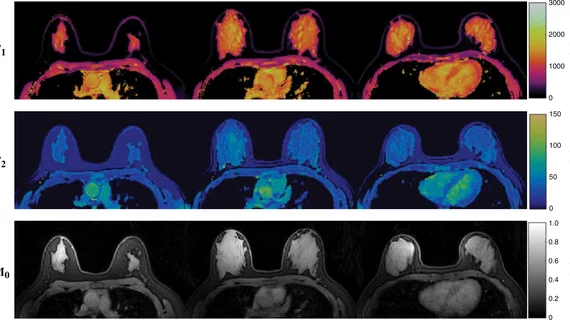New technique brings MR fingerprinting to breast imaging
A new breast imaging technique uses MR fingerprinting for the volumetric quantification of T1 and T2 relaxation times for breast tissue, according to new research published in Radiology.
MR fingerprinting has helped researchers study prostate cancer and brain tumors, the authors noted, but not breast tissue.
“To our knowledge, the development of an MR fingerprinting approach for breast imaging has not been previously explored because it poses technical challenges not encountered in other applications,” wrote lead author Yong Chen, PhD, of Case Western Reserve University in Cleveland, and colleagues. “Most current MR fingerprinting techniques generate two-dimensional tissue property maps. For breast imaging, an MR fingerprinting method with volumetric coverage is strongly preferred, as breast cancers can be multicentric and multifocal. Because of the high fat content in the breasts, major challenges from both static and transmit magnetic field inhomogeneities are also expected.”
The authors validated their technique with phantoms and then applied it to 15 healthy female patients and 14 female patients with breast cancer between March 2016 and April 2016. The phantom results revealed “accurate and volumetric” T1 and T2 quantification using the team’s technique, according to the study. The acquisition time was approximately six minutes.
For healthy patients, the average T1 relaxation time for fibroglandular tissues was 1256 milliseconds ± 171. The average T2 relaxation time for fibroglandular tissues was 46 milliseconds ± 7. No statistical difference was observed between the T1 relaxation times of healthy patients and those with breast cancer. Breast cancer patients did have higher T2 relaxation times, however.
“The T1 and T2 relaxation times acquired with the proposed method are in good agreement with literature values,” the authors noted.
Chen and colleagues added that a big drawback to their method is the costs associated with MR imaging.
“Major efforts have therefore been spent to reduce the imaging time to only a few minutes per study participant while maintaining similar diagnostic accuracy,” the authors wrote. “Our present work is designed to create a form of functional evaluation for the breast and would likely result in more table time. The two are different (and potentially complementary) developments with different goals.”
The team also noted that the sample size for its study was small. Future research will be focused on larger patient cohorts.

